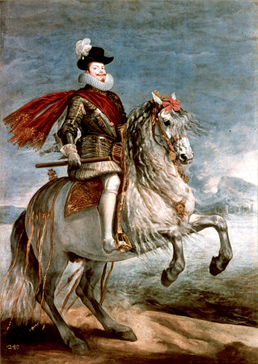

ver the centuries and across the world, horses have been selectively bred for specific purposes, thereby producing certain types and characteristics with each breed that created various methods of training and riding. Appreciating the difference between the classically bred and the competitively bred dressage horse enables us to tailor a training program that respects the heritage and the nature of the horse without creating injury. The Iberian horse, the Spanish Andalusian or PRE, and the Portuguese Lusitano or PSL, has remained relatively unchanged throughout the centuries, and they still possess the qualities that made them the fountainhead of classical dressage and the most desired riding horse of the baroque era.[1] In the twenty-first century, anyone can engage in this graceful equestrian art through the Baroque Equestrian Games.[2]
 Lusitanos, the oldest saddlehorses in the world, have a rich history that dates back over 5000 years. Volumes have been written about this majestic and distinguished breed. They were originally war horses that effectively helped to draw the boundaries of what is now Portugal.[3] Can you imagine as a warrior, how attached you would become to this incredible mount that worked with you in battle, exhibiting the miraculous moves needed to save your life? Today, Lustianos compete in every area of equestrian competition, dressage, eventing, western events and are still in the bull ring in Portugal fighting the bulls. The experts in equestrian sports call them versatile, docile, agile and courageous. When you have found yours, you have found a soul mate!
Lusitanos, the oldest saddlehorses in the world, have a rich history that dates back over 5000 years. Volumes have been written about this majestic and distinguished breed. They were originally war horses that effectively helped to draw the boundaries of what is now Portugal.[3] Can you imagine as a warrior, how attached you would become to this incredible mount that worked with you in battle, exhibiting the miraculous moves needed to save your life? Today, Lustianos compete in every area of equestrian competition, dressage, eventing, western events and are still in the bull ring in Portugal fighting the bulls. The experts in equestrian sports call them versatile, docile, agile and courageous. When you have found yours, you have found a soul mate!
Below is footage of a magnificient baroque horse under saddle: Don E Mor's own Quedimas Smar.
[1] cited within Wikipedia, entry on Lusitano from "Lusitano," International Museum of the Horse. Retrieved 2009-11-13.
[2] more informaiton on the Baroque Equestrian Games can be found here.
[3] From Arsenio Raposo Cordeiro's, Lusitano Horse The Son of the Wind, 3rd Ed. Lisboa, 2002


